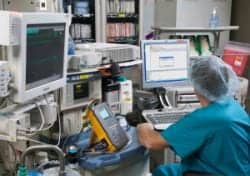Below, four experts in the computerized maintenance management systems (CMMS) segment—Kim Stovall, director of sales at Charlotte, N.C.-based EQ2, LLC; Jeremy Fortune, client success manager at Phoenix Data Systems in Southfield, Mich.; Bryan Christiansen, founder and CEO of Lehi, Utah-based Limble CMMS; and Matthew Baretich, PE, PhD, president of Fort Collins, Colo.-based Baretich Engineering, Inc. and co-author of Computerized Maintenance Management Systems for Healthcare Technology Management (AAMI 2017)—reveal how the COVID-19 pandemic has impacted the CMMS market and what buyers should know before purchasing CMMS technologies.
24×7 Magazine: The past year has been unprecedented, to say the least. In what ways has the pandemic affected the CMMS segment?
Bryan Christiansen: CMMS [technologies] can be used in any industry that depends on their physical equipment and infrastructure. As such, the need for CMMS software increased in industries that were growing (food manufacturing, healthcare, delivery services, etc.) and decreased in those that were hit the hardest by the pandemic—for instance, the hospitality industry. Overall, the CMMS segment continues to grow as the trend to use technology to manage maintenance is only getting stronger.
Jeremy Fortune: With many of our CMMS users transitioning to remote working, a lot of hospitals concentrated on data quality. Using existing functionality in Phoenix’s AIMS CMMS, users were able to focus in on their data and start to clean it up. This clean up led to an increased need for broader visibility, thus an increased demand for reporting opportunities. This past year also affected some of the services we as a vendor provide and that our clients rely on. Instead of abandoning these services, such as training and our annual user symposium, we went virtual. While the experience was different for both sides, it’s safe to say that some of these virtual options are here to stay.
Matt Baretich: HTM professionals have had to adjust their operations as the pandemic developed. For example, because of the public health emergency, [the Centers for Medicare & Medicaid Services] and accrediting organizations like The Joint Commission allowed exceptions to some of their rules. We needed to be able to take advantage of those exceptions while fully documenting our compliance with changing operations. We have also had to adjust work assignments on the fly, accommodate emergency-use medical devices, and sometimes handle high patient census levels. CMMS software needed to be flexible and easy to reconfigure.
Kim Stovall: HTM leaders needed to use their CMMS to identify devices that were in quarantined patient areas and they needed to adjust or suspend preventive maintenance on these devices. The CMMS was also used to identify devices that could be used for respirators, which normally weren’t utilized for life support.
Larger healthcare systems leveraged equipment transfer capabilities, as equipment was temporarily redistributed to other hospitals experiencing a patient surge. HTM leaders had to keep track of the additional rental equipment that was needed during the surge. So, CMMS vendors like EQ2 spent time helping customers adapt their CMMSs to this new normal in the healthcare segment.
Also, many HTM leaders started working from home to access their CMMS, so the CMMS vendors worked with the hospital’s network security teams to set up virtual private networks, or VPNs, to authenticate user credentials to gain hospital network access to their CMMS. Likewise, many clients and future clients found their operating budgets frozen due to the economic impact of the pandemic on the healthcare organization. As a result, many HTM leaders postponed their CMMS upgrade or new CMMS purchase. Lastly, the cancellation of many of the HTM seminars eliminated some of the common opportunities for HTM leaders and CMMS vendors to meet face to face, making the product evaluation process more difficult.
24×7: In a nutshell, why should hospitals invest in CMMS software?
Fortune: CMMS software is essential for HTM departments and should offer more than just asset- and work-order tracking. It should be utilized and regarded as a tool that provides visibility, efficiency, and organization. With the right CMMS, you will be able to instantly gather department insights through reporting and clean data, analyze part usage, calculate contract valuations, and employ departmental processes and workflows, all from inside the software. When the CMMS offers these opportunities, you’ll not only see increased efficiency and lower costs, but streamlined operations.
Stovall: The CMMS is the best means for managing the HTM department and the healthcare organization’s assets. It can be used to extract key performance indicators, or KPIs, helping demonstrate your department’s performance; for guiding improvements; and for C-suite reporting. Along these lines, adherence to regulatory compliance can be demonstrated to regulators, which also results in a safe environment for both patients and staff.
Specifically, dashboards allow managers to monitor department KPIs in real time while performance benchmark analyzers allow them to further examine their department’s performance with the capability to compare results year-over-year or against other hospitals within the organization.
In the end, a healthcare organization will use the CMMS to increase work efficiency, reduce equipment downtime, assist in capital equipment planning, obtain total cost of ownership history, and assist in cybersecurity management. Essentially, the CMMS performs like an asset management hub, connecting to other key information systems within the organization. After all, ‘we can’t improve what we don’t measure,’ and the CMMS provides all the needed KPIs for process improvement, along with reporting of those KPI metrics to demonstrate those successes to the C-suite.
Christiansen: In hospitals, more than anywhere else, maintenance literally saves lives. CMMS helps hospitals run preventative and predictive maintenance, which significantly reduces the chance that a critical piece of equipment will fail, whether it’s a backup generator, equipment keeping the negative pressure in the room, or other life-saving equipment.
The other big reason companies should use a CMMS is to lower their operational costs. CMMS facilitates that by reducing the number of costly breakdowns; improving asset efficiency, which impacts building energy consumption; and lowering vendor and spare parts management costs. After all, it’s much cheaper to maintain equipment than to repair it—and most breakdowns are preventable.
24×7: Before purchasing software, what should hospitals know? Are there any potential red flags they should avoid?
Christiansen: They should be aware of their maintenance needs so they can look for a CMMS with the right set of features. Hospitals usually have different types of maintenance requirements. The operations team that deals with day-to-day issues, the janitorial team for cleaning requirements, and specialized repairs that are performed by equipment manufacturers/[biomeds]. To efficiently deal with all types of maintenance work, they usually need a solution with a work request portal and a capable vendor management module for tracking and managing outsourced maintenance work. They may also want a solution that supports QR codes for quick asset identification and can be integrated with sensors for predictive maintenance.
In general, what we tell all potential clients, regardless of the industry, is to always shortlist a few tools and test them. All CMMS providers state in their marketing materials how their solution is easy to adopt and use, but many are not. One of the biggest benefits of implementing a CMMS is the data it offers, but you are not going to get good data if the software is complicated (because it will be used infrequently and improperly).
Stovall: Today, the CMMS is more than software just for work order and inventory management. The CMMS needs to interface with other information systems within the organization, such as procurement, supply chain, cybersecurity, and service manual access, to name a few; and even if not right now, the flexibility to add these features in the future is important. Consequently, HTM leaders must outline their department goals and objectives and then evaluate CMMS products in accordance with them.
Most HTM departments today identify mobility, dashboards, application programming interfaces for interfacing, analytics, reporting tools, and the need to meet certain HTM workflows. They may want the CMMS to have HTM rules built-in such as [alternative equipment maintenance]/OEM segregation, electronic protected health information, regulatory compliance, and compliance exception-handling.
A CMMS not focused on healthcare may be okay for colleges, hotels, restaurants, retail, etc., but it’s a poor match for HTM. With healthcare focus comes healthcare experience and a product design incorporating the rules and regulations that apply to HTM. Finally, selecting a CMMS is a vendor-partnering decision. It’s important that the vendor has a commitment to post-installation customer support; listens to and responds to customer requests; and perhaps, most importantly, understands the nuances of HTM.
Baretich: All CMMS software packages do the basics: inventorying, PM scheduling, repair history, etc. Excellent CMMS software distinguishes itself by its ability to interface with other software systems, including real-time locating systems, financial systems, supply chain systems, safety and alert management systems, IT databases, and more.
Fortune: The most important thing to consider before purchasing a CMMS is the relationship that is created and fostered between the vendor and client. Many may not think about the length of time between the software purchase through go-live—and depending on the vendor, this time could be significant. With that in mind, it’s paramount that hospitals evaluate the following:
- Implementation timeline: How long will it be until you can use the software?
- Software conversions: Does the vendor convert all of your legacy data?
- Training quality: Does the vendor provide high-quality training to all the CMMS users, including administrators, directors, managers, and technicians?
- Technical support availability: Can you reach the vendor when you need help?
- Adherence to industry mandates: Is the vendor able to quickly incorporate new mandates into the CMMS?
- Version updates: Is the vendor able to provide software updates or do these updates have to be handled on an individual client basis?
- Enhancement requests: Does the vendor take the client’s ideas into consideration?
In addition to the items listed above, you should also talk to others in the industry. While at tradeshows or conferences, ask them about their own experiences with the vendor. Don’t use the vendor’s references as your only point of contact when evaluating different CMMS options.
24×7: What are some of the top trends in the CMMS software segment right now? What do you anticipate will be the “latest and greatest” in CMMS software in the next few years?
Baretich: Configurability and integration. The best CMMS software will expand its focus beyond basic maintenance management functions to full-scale HTM operational support. That includes support for standardized metrics that will allow performance benchmarking across organizations.
Stovall: One of the top trends for 2021 is the use of mobility products to increase work efficiency and interface with other information systems. Because more managers are realizing that they are not capturing all the work being performed by their departments or are failing to accurately report on work-order response and close times, the use of mobility applications has become nearly as important as using the desktop version.
In the coming years, the hospital supply chain will capture the full lifecycle costs of the assets within an organization. In other words, the asset information will be captured when the order is placed; HTM will manage the device over its active lifecycle and then initiate the decommissioning of the device, with supply chain then recording the process. This is a total asset management, “cradle-to-grave” process. As more medical devices become smart devices, we can see an increased demand for Integrating the Healthcare Enterprise-Patient Care Device (IHE-PCD) where devices will request service and initiate work orders before they fail.
With IHE-PCD, the HTM department will become more proactive than reactive in its service efforts, and metered PM will be enhanced as well. Lastly, the use of artificial intelligence should gain ground, which will further identify trends in asset history and predictability of asset failures—all important in the asset’s lifecycle management. Combining all these capabilities will further improve the utilization of medical devices, reducing the time devices are down or lost and helping to improve the return on investment of the capital equipment.
Fortune: In 2021, the desire for cloud-hosted software increased. More and more hospitals recognized the need for 24×7 access, less expensive storage options, and the opportunity to free themselves of their reliance on their in-house IT department.
As stated above, data quality is a common trend among AIMS users for both 2020 and 2021. What the CMMS can do with regard to facilitating an AEM program is another hot-button issue. For users, it’s important that the CMMS can help them classify eligible equipment, track AEM evaluations, and identify which equipment is on an AEM schedule and why.
Farther into the future, CMMSs will have to account for a probable shift to environment-based maintenance. Instead of performing preventive maintenance and corrective maintenance, technicians will provide maintenance based on how often the equipment is used, where it’s located, and how much it has been abused or accidentally damaged. Finally, users may see an increase in CMMS vendors assisting with compliance surveys. HTM departments will no longer have to rely on the CMMS as their only tool for compliance. Instead, those who actually created the software will become an asset to the passing of their surveys.
24×7: What else should 24×7 Magazine readers know about the CMMS sector?
Fortune: When you’re evaluating a new CMMS, it’s important to remember that it’s not just about the look of the software. You need to consider the features and functionalities as well, including core functionalities, robust reporting capabilities, AEM capabilities, workflows, data integrity capabilities, mobile options, and more.
Be sure to get the complete picture about the implementation process and post-go-live support. You’ll want to partner with a vendor who can move you through this process timely and efficiently. It’s also important to ask about the conversion process to verify that your legacy data comes over to your new system, in order to eliminate daily usage of two systems. Lastly, you’ll want to make sure your software can be updated with industry mandates and software enhancements, without customizations having to be scheduled for your individual instance of the CMMS.
Stovall: Today, the CMMS can function as an asset management hub connected to other asset management information systems throughout the organization or the organization’s suppliers. With these interfaces, assets can be flagged by cybersecurity appliances and have work orders created. Service calls can then be automatically routed to the responsible engineer, and technicians can order parts from within the work order via a procurement interface and onsite via their mobile application.
Modern CMMS applications simplify and assist with the HTM workflow; so as assets are added to the system, the properties are automatically inherited. Advanced planned maintenance schedules can easily be arranged and tracked by the system with dashboards providing real-time feedback on completion.
Additionally, other departments are using the CMMS information for complete asset management or to track their own department’s KPIs: downtime, regulatory compliance, etc. Also, the CMMS product is continually evolving to provide additional CMMS features and system interfacing with other information systems or Internet of Medical Things devices to assist the HTM leaders with both workflow and asset management.
The good CMMS vendors will continue to advance their offerings, responding to user needs and aligning with new device technology. A good HTM CMMS is not a burden—rather, it is the primary tool for managing an effective, efficient HTM department.
Christiansen: There are many different solutions in the market, and it pays to take time to find the one that is the best fit for your facility. Alongside features and reviews, it’s very important to find a vendor with great customer support to help with the transition process.
Baretich: Before changing from one CMMS package to another, do your homework. Prepare a detailed requirements document and decide how you’ll compare your current package to available alternatives. After all, there are many excellent packages available.





